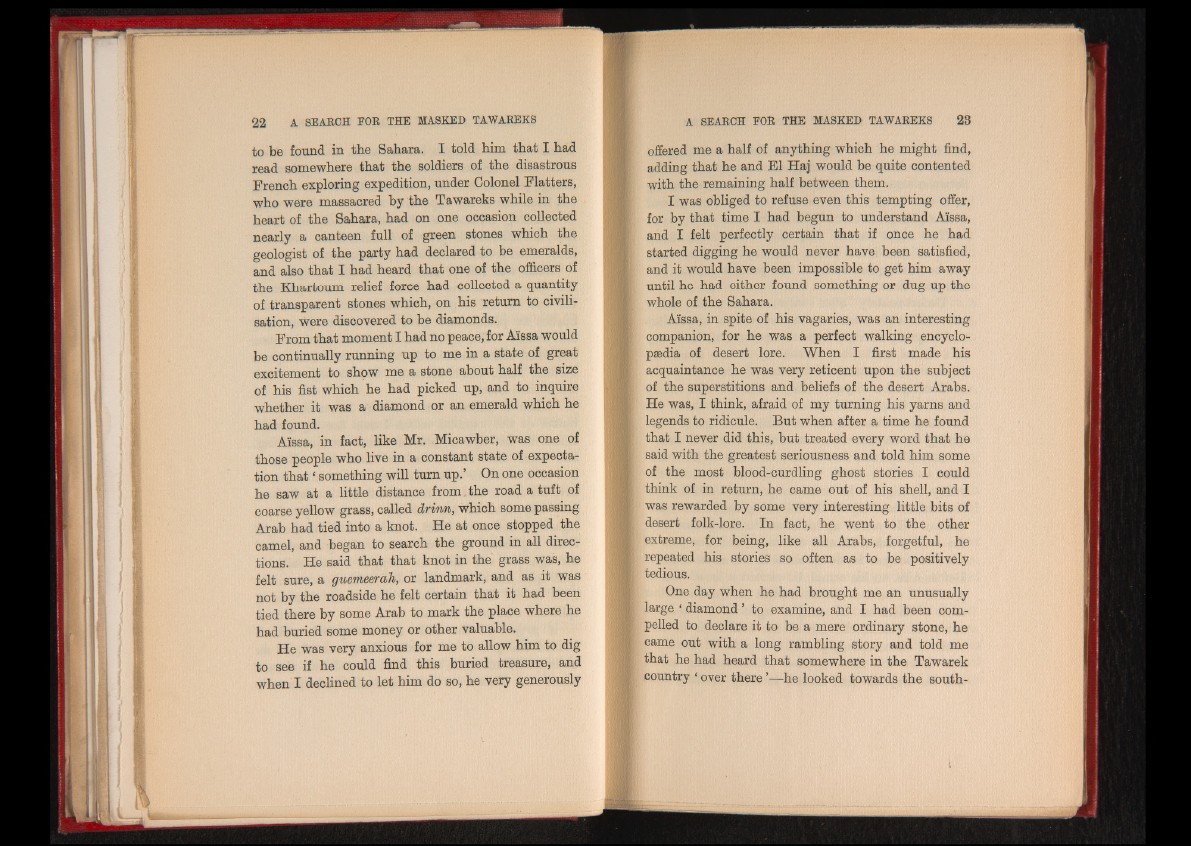
to be found in the Sahara. I told him that I had
read somewhere that the soldiers of the disastrous
French exploring expedition, under Colonel Flatters,
who were massacred hy the Tawareks while in the
heart of the Sahara, had on one occasion collected
nearly a canteen full of green stones which the
geologist of the party had declared to be emeralds,
and also that I had heard that one of the officers of
the Khartoum relief force had collected a quantity
of transparent stones which, on his return to civilisation,
were discovered to be diamonds.
From that moment I had no peace, for Aissa would
be continually running up to me in a state of great
excitement to show me a stone ahout half the size
of his fist which he had picked up, and to inquire
whether it was a diamond or an emerald which he
had found.
Aissa, in fact, like Mr. Micawber, was one of
those people who live in a constant state of expectation
that ‘ something will turn up.’ On one occasion
he saw at a little distance from, the road a tuft of
coarse yellow grass, called drinn, which some passing
Arab had tied into a knot. He at once stopped the
camel, and began to search the ground in all directions.
He said that that knot in the grass was, he
felt sure, a guemeerah, or landmark, and as it was
not by the roadside he felt certain that it had been
tied there by some Arab to mark the place where he
had buried some money or other valuable.
He was very anxious for me to allow him to dig
to see if he could find this buried treasure, and
when I declined to let him do so, he very generously
offered me a half of anything which he might find,
adding that he and El Haj would be quite contented
with the remaining half between them.
I was obliged to refuse even this tempting offer,
for by that time I had begun to understand Aissa,
and I felt perfectly certain that if once he had
started digging he would never have been satisfied,
and it would have been impossible to get him away
until he had either found something or dug up the
whole of the Sahara.
Aissa, in spite of his vagaries, was an interesting
companion, for he was a perfect walking encyclopaedia
of desert lore. When I first made his
acquaintance he was very reticent upon the subject
of the superstitions and beliefs of the desert Arabs.
He was, I think, afraid of my turning his yarns and
legends to ridicule. But when after a time he found
that I never did this, but treated every word that he
said with the greatest seriousness and told him some
of the most blood-curdling ghost stories I could
think of in return, he came out of his shell, and I
was rewarded by some very interesting little bits of
desert folk-lore. In fact, he went to the other
extreme, for being, like all Arabs, forgetful, he
repeated his stories so often as to be positively
tedious.
One day when he had brought me an unusually
large ‘ diamond ’ to examine, and I had been compelled
to declare it to be a mere ordinary stone, he
came out with a long rambling story and told me
that he had heard that somewhere in the Tawarek
country * over there ’—he looked towards the south